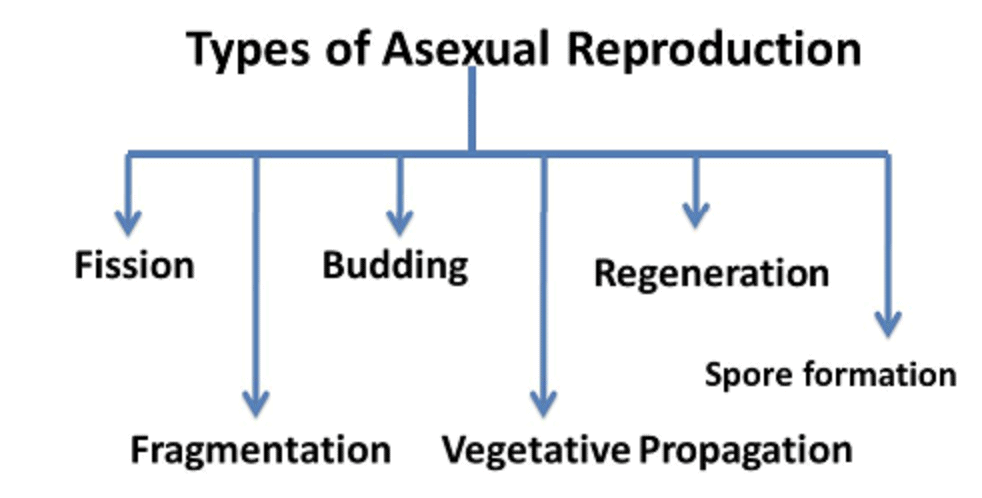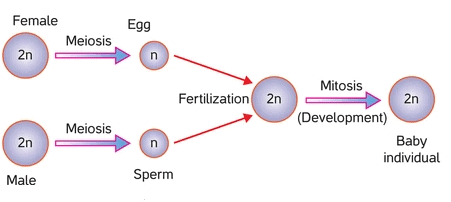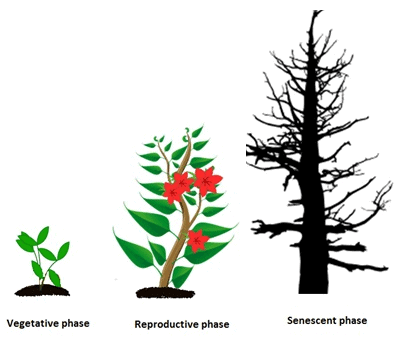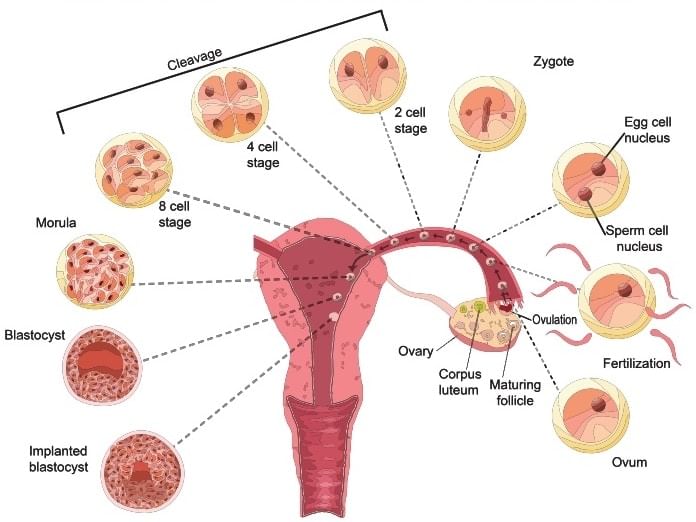Modes of Reproduction: Asexual & Sexual | Additional Study Material for NEET PDF Download
| Table of contents |

|
| What is Reproduction? |

|
| Lifespan |

|
| Modes of Reproduction |

|
| Events in Sexual Reproduction |

|
What is Reproduction?
Reproduction is a biological process of the formation of new offsprings from the pre-existing organism.
Reproduction becomes a vital process without which species cannot survive for long. It ensures continuity of species generation after generation as older individuals undergo senescence and ultimately they die.
Lifespan
The period from birth to the natural death of an organism represents its lifespan. The lifespan of organisms varies from a few days (Butterfly-1 to 2 weeks) to thousands of years (Banyan tree).
 The lifespan of a human
The lifespan of a human
Modes of Reproduction
Based on whether there are one or two organisms taking part in the process of reproduction.
- Asexual Reproduction: When the offspring is produced by single parents with or without the involvement of gamete formation, the reproduction is called Asexual reproduction.
- Sexual Reproduction: When two parents (opposite sex) participate in the reproductive process and also involve fusion of male and female
gametes, it is called Sexual reproduction.
1. Asexual Reproduction
- Usually followed by organisms with relatively simpler organizations.
- Offsprings produced by a single parent.
- With/without the involvement of gamete formation.
- Offsprings produced genetically and morphologically, similar to each other and to the parent, i.e. they are clones.
- In Protista and Monera, the parent cells divide into two to give rise to new individuals.
- Thus, in these organisms cell division is the mode of reproduction itself.
- Asexual reproduction is the most common method of reproduction in organisms having a Material similar body like in algae and fungi but during the unfavorable condition, they shift to sexual reproduction.
Types of Asexual Reproduction
 Classification of Asexual Reproduction
Classification of Asexual Reproduction
(a) Binary Fission
- The term “fission” means “to divide”. During binary fission, the parent cell divides into two cells. The cell division patterns vary in different organisms, i.e., some are directional while others are non-directional. Amoeba and euglena exhibit binary fission.
 Binary Fission in Amoeba
Binary Fission in Amoeba - It is one of the simplest and uncomplicated methods of asexual reproduction. The parent cell divides into two, each daughter cell carrying a nucleus of its own that is genetically identical to the parent. The cytoplasm also divides leading to two equal-sized daughter cells. The process repeats itself and the daughter cells grow and further divide.
(b) Budding
- Budding is the process of producing an individual through the buds that develop on the parent body.
- Hydra is an organism that reproduces by budding. The bud derives nutrition and shelter from the parent organism and detaches once it is fully grown.
 Budding in Hydra
Budding in Hydra
(c) Fragmentation
- Fragmentation is another mode of asexual reproduction exhibited by organisms such as spirogyra, planaria etc.
 Fragmentation in Spirogyra
Fragmentation in Spirogyra - The parent body divides into several fragments and each fragment develops into a new organism.
(d) Vegetative Propagation
- Asexual reproduction in plants occurs through their vegetative parts such as leaves, roots, stems, and buds. This is called vegetative propagation.
- Example: Potato tubers, Runners/stolon, Onion bulbs, etc., all reproduce through vegetative propagation.

(e) Regeneration
- Regeneration is the power of growing a new organism from the lost body part. For eg., when a lizard loses its tail, a new tail grows. This is because the specialized cells present in the organism can differentiate and grow into a new individual.
- Organisms like hydra and planaria exhibit regeneration.
 Regeneration in Planaria
Regeneration in Planaria
(f) Spore Formation
- Spore formation is another means of asexual reproduction. During unfavourable conditions, the organism develops sac-like structures called sporangium that contain spores.
 Spore Formation
Spore Formation - When the conditions are favourable, the sporangium burst opens and spores are released that germinate to give rise to new organisms.
Advantages of Asexual Reproduction
Following are the advantages of asexual reproduction:
- Mates not required.
- The process of reproduction is rapid.
- An enormous number of organisms can be produced in very less time.
- Positive genetic influences pass on to successive generations.
- It occurs in various environments.
Disadvantages of Asexual Reproduction
The major disadvantages of asexual reproduction are:
- Lack of diversity. Since the offsprings are genetically identical to the parent they are more susceptible to the same diseases and nutrient deficiencies as the parent. All the negative mutations persist for generations.
- Since only one organism is involved, the diversity among the organisms is limited.
- They are unable to adapt to the changing environment.
- A single change in the environment would eliminate the entire species.
2. Sexual Reproduction
- Involves the formation of male and female gamete by two individuals of the opposite sex.
- Offspring produced by fusion of male and female gametes not identical to each other or to the parents.
 Sexual Reproduction
Sexual Reproduction - All sexually reproducing organisms share a similar pattern of reproduction.
- In sexual reproduction, a fusion of male and female gametes results in offspring that are not identical to parents.
Different Phases in Sexual Reproduction
 Phases of Life
Phases of Life
1. Juvenile Phase/Vegetative Phase
- The period between birth and sexual maturity is called the juvenile phase. In plants, it is known as the Vegetative phase.
- The end of the juvenile/vegetative phase marks the beginning of the reproductive phase.
2. Reproductive Phase
- Some plants show flowering in a particular season and some other flowers in all seasons. Some other plants like bamboo species flowers once in a lifetime (after 50-100 years), Strobilanthes kunthiana (neelakuranji), flowers once in 12 years.
- The female placental animals exhibit a cyclic change in activities ovaries and accessory glands as well as hormones during the reproductive phase.
(i) Menstrual Cycle: It occurs in monkeys, apes and human beings.
- The cycle consists of 3 phases-menstrual, proliferative and secretory phase.
- Blood flows in the last few days of the cycle. The broken endometrium is passed out during menstruation.
- Female does not permit copulation during the menstrual phase of the cycle.
(ii) Oestrous Cycle: It occurs in non-primates like cow, sheep, rat, deer, dog, tiger etc.
- It consists of a short period of oestrous or heat. it is 12-24 hours in cow followed by an oestrous or passive period.
- Blood does not flow in this cycle. The broken endometrium is reabsorbed.
- Female permits copulation only during the oestrous period.
- Both in plants and animals, hormones are responsible for the transition between different phases of the life cycle. Interaction between hormones and environmental factors regulates the reproductive processes.
3. Senescent Phase:
- It is the end of the reproductive phase. Old age ultimately leads to death.
Events in Sexual Reproduction


(a) Pre-fertilisation
All the events prior to the fusion of gametes are included in it.
It includes gametogenesis and gamete transfer:
(i) Gametogenesis
- Gametogenesis is the process of the formation of male and female gametes. Gametes are haploid cells that may be similar or dissimilar in structure. In algae, both gametes are similar in structure called homogametes (isogametes).
 Gametogenesis
Gametogenesis - In higher organism that reproduces sexually, two morphologically distinct gametes are formed called heterogametes, male gametes are called antherozoid or sperm and female gametes are called ovum or egg.
- In fungi and plants, homothallic and monoecious terms are used to denote the bisexual condition and heterothallic and dioecious are used for unisexual conditions. In flowering plants, the unisexual male flower is staminate, i.e., bearing stamens, while the female is pistillate or bearing pistils.
- In animals, species that possess both male and female reproductive organs in the same individual are called bisexual or hermaphrodites (earthworm, sponges, tapeworm etc.) and both having either male or female reproductive organs are called unisexual (cockroach, human).
- Gametes are always haploid( having half set of the chromosome), although organisms may be haploid and diploid. Diploid organisms form gametes by meiotic division. The organisms belonging to algae, fungi, and bryophytes have haploid plant bodies and pteridophytes, gymnosperms, angiosperms and most of the animals are diploid (having a double set of the chromosome).
- In diploid organisms, gamete mother cell (meiocyte) undergoes meiosis in which one set of the chromosome is present in gametes.
(ii) Gamete Transfer
- In the majority of organisms, male gametes are motile and females gametes are non-motile, except in fungi and algae in which both gametes are motile.
- In simple plants like algae, fungi, bryophytes and pteridophytes, water is the medium through which male and female gametes move. The number of male gametes is much more than the number of female gametes as most of the male gametes fail to reach the female gametes.
- In higher plants, pollen grains are a carrier of male gametes and the ovule has eggs. Pollen grains must be transferred from anther to stigma to facilitate fertilization. The transfer of pollen grains from anther to stigma is called pollination. Pollination may be self (anther to the stigma of the same flower) or cross (anther to the stigma of a different flower).
- Pollen grains germinate on stigma to produce a pollen tube that delivers the male gametes near the ovule.
(b) Fertilisation
- The fusion of male and female gamete is called fertilization or syngamy. It results in the formation of a diploid zygote.
- The process of the development of new organisms without fertilization of female gametes is called parthenogenesis.
Example: Honey bee, Rotifers, and Lizards
(c) Post Fertilisation Events
 Fetal development from ovulation to implantation
Fetal development from ovulation to implantation
(i) The Zygote
- Events in the sexual reproduction after the formation of zygote.
- A zygote is a vital link that ensures continuity of species between organisms of one generation and the next.
- Every sexually reproducing organism, including human beings, begin life as a single cell–the zygote.
- In the organisms, having external fertilisation, the zygote is formed in an external medium (water) and those having internal fertilisation zygote is formed inside the body of the female.
- In algae and fungi, the zygote develops a thick wall resistant to desiccation and damage. This germinates after a period of rest.
- In the organisms having a haplontic life cycle, the zygote divides to form haploid spores that germinate to form haploid individuals.
(ii) Embryogenesis
- The process of development of an embryo from the zygote. During this, the zygote undergoes mitotic division and cell differentiation.
 Human Embryonic Development
Human Embryonic Development - Cell division increases the number and cell differentiation helps the information of a new group of cells and organs.

- In flowering plants, the zygote is formed inside the ovule. After fertilization, sepals, petals, and the stamens of flowers fall off. The zygote develops into an embryo and ovules into seeds. The ovary develops into fruits which develop a thick wall called the pericarp, protective in function.
- After dispersal, seeds germinate under favourable conditions to produce new plants.
|
26 videos|312 docs|64 tests
|
FAQs on Modes of Reproduction: Asexual & Sexual - Additional Study Material for NEET
| 1. What is reproduction? |  |
| 2. What is the lifespan of an individual organism? |  |
| 3. What are the modes of reproduction? |  |
| 4. What are the events involved in sexual reproduction? |  |
| 5. What are the advantages and disadvantages of asexual and sexual reproduction? |  |
















